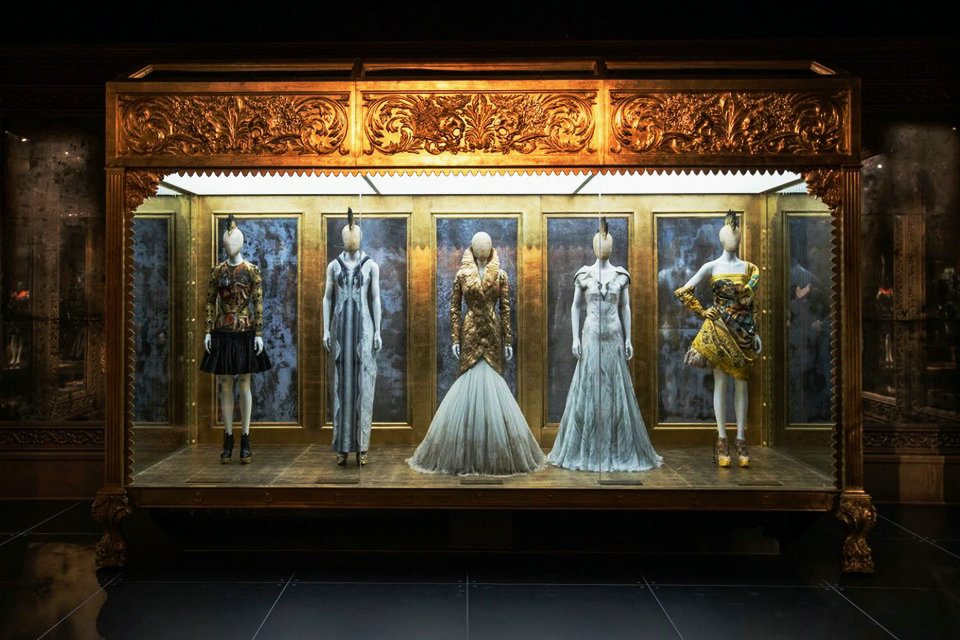The Craftsmanship of Alexander McQueen, 360°Video, British Fashion Council


Innovative, emotional, uncompromising. Welcome to the house of Alexander McQueen. Since its founding in 1992 by Lee Alexander McQueen, the company has grown to become one of the most important and respected fashion brands in the world. Known for the emotional power and raw energy of its shows and a profound respect for craftsmanship, Alexander McQueen is a standard bearer for British fashion. Today, under the direction of Sarah Burton, the brand combines an in-depth knowledge of British tailoring with a unique creativity that sets Alexander McQueen apart.
Alexander McQueen’s eponymous fashion house still continues today and you can explore the craftsmanship and intricate details in its designs in this 360 video, discover the innovative and uncompromising craftsmanship behind the house of Alexander McQueen. Join a virtual reality tour of five iconic pieces by Sarah Burton for Alexander McQueen. Sarah Mower, the Chief Critic of Vogue.com, narrates this tour showing Alexander McQueen’s craftsmanship and creativity.
Alexander McQueen is known for an emotional power and raw energy, as well as its romantic but determinedly contemporary nature.
Integral to the McQueen aesthetic is the juxtaposition between contrasting elements: fragility and strength, tradition and modernity, fluidity and severity. An openly emotional and even passionate viewpoint is realised with a profound respect for artisanal techniques and craftsmanship.
His gripping designs were often autobiographical, taking inspiration from subjects such as his Scottish heritage or his passion for scuba diving, as well as from pop culture, art and history. They earned him a host of celebrity fans and his clothes were seen on the likes of David Bowie, Sarah Jessica Parker, Beth Ditto and Björk.
McQueen’s often aggressive and violent themes polarized audiences, although largely the dark aesthetic of his designs made them memorable and thought-provoking.
Demonstration works:
Spring/Summer 2017 Look 44
This dress was one of the final looks in the Spring/Summer 2017 show. The collection was inspired by the Shetland Islands and the wild, mythical nature of their coastline. This black tulle dress depicts a shipwreck engulfed by the waves.
The ship itself was created using two and three millimetre beads, bugle beads, micro black glass beads, black hammered bullion and black metallic thread.
Around 500,000 sequins were then used to recreate the waves with facetted small silver glass beads outlining each one.
Hammered silver bullion recreates the splashes. Hanging beaded fringes were placed between the flat wave designs and silk tulle ruffles to create a smooth transition.
Thirty metres of embroidered silk ruffles and thirty metres of silk tulle then capture the movement of waves, each one gathered and steamed to give a wave effect.
Spring/Summer 2017, Look 42
This dress depicts an island scene with Shetland sea birds and coastal plants from cornflowers to lakeshore bulrushes, rock roses, cormorants and puffins. The dress has an almost etched effect which was achieved through a large number of materials and techniques: black bullion embroidery, metal thread embroidery, shiny micro ribbon work, round glass beads, faceted glass beads, sequins and bugle beads.
Autumn/Winter 2016, Look 27
This black leather plonge dress has boning details within the upper body and an accentuated hip silhouette. The dress was part of the Autumn/Winter 2016 collection inspired by a surreal and ethereal night time world. Here intoxicating white flowers of tuberose,’Queen of the Night,’ and jasmine, which bloom only after dark are painted onto leather entirely by hand in chiaroscuro shades of shadow and light.
Look 27, designed by Sarah Burton, on the catwalk in Paris during the Alexander McQueen Autumn/Winter 2016 presentation.
Spring/Summer 2016, Look 28
This frock coat is based on an antique Victorian jacket, cut to elongate and accentuate an hourglass silhouette. The coat was reworked and modernised using Japanese denim, aged with a vintage wash and frayed edges which accentuate the form and cut of the split waist seaming.
The floral embroidery is based on ‘Spitalfields’ silk, created by the Huguenots who arrived in London as religious refugees in the late seventeenth century. They brought with them their skill in weaving and a love of naturalistic floral designs inspired by “The Line of Beauty” philosophy. The coat is embellished with hand-dyed sequins, multi-coloured glass beads and micro glass bugle beads over dyed jacquard patches. You will see three-dimensional beaded techniques, raised satin stitch, bullion, French knots and faceted glass beads.
Detail of a Spitalfields Silk Coat from 1734. This men’s coat is made from khaki silk, brocaded with coloured silk in a floral pattern. The coat was woven in Spitalfields by Huguenot religious refugees and is part of the Victoria and Albert Museum collection.
Spring/Summer 2016, Look 39
This dress was inspired by armour. The top is a lace patchwork using lace and guipure while the skirt is created with hand-stitched ostrich feather with wet-look effect. A hand-stitched panel of dyed goose feathers has been inserted between the top and the skirt.
Look 39, designed by Sarah Burton, on the catwalk in Paris during the Alexander McQueen Spring/Summer 2016 presentation.